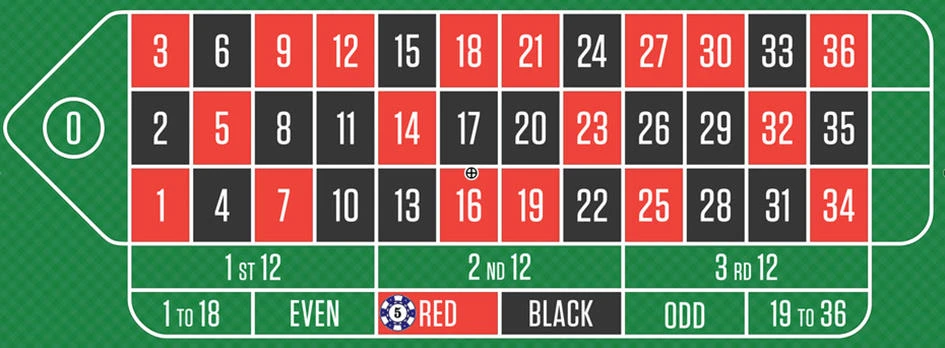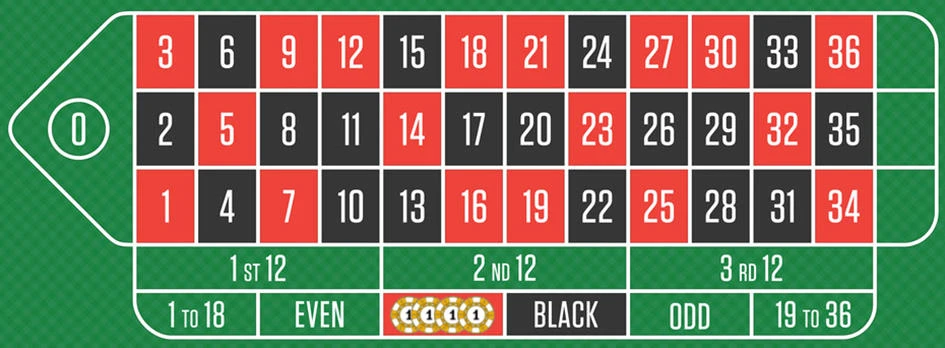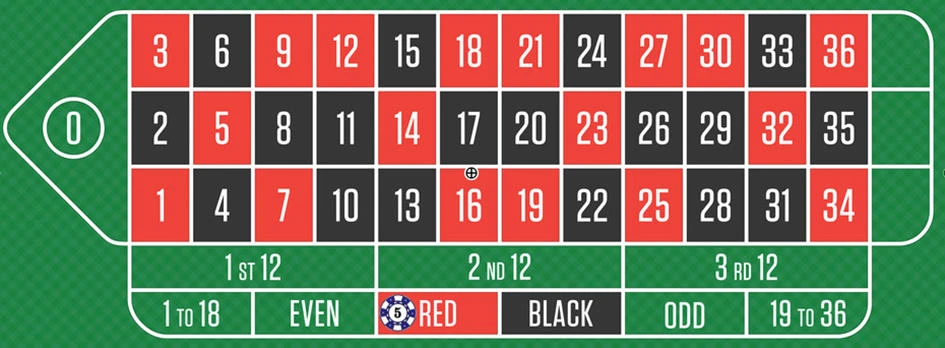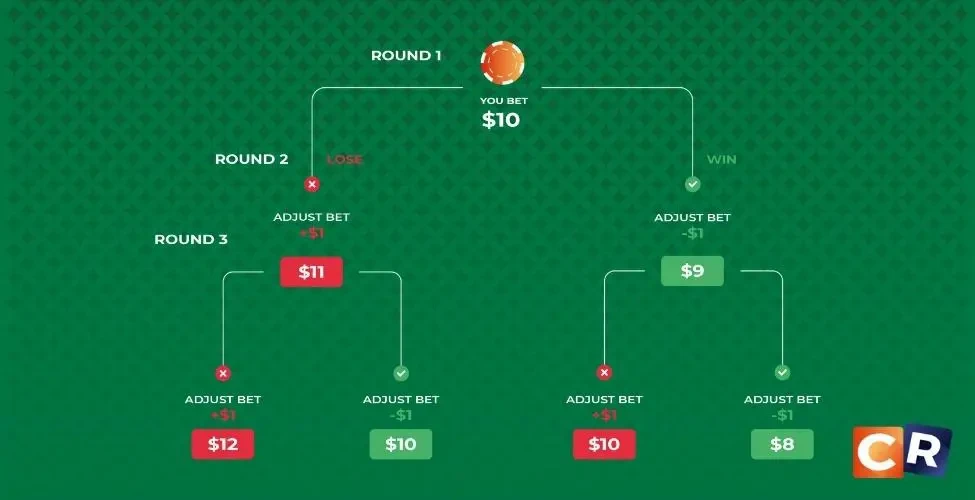
The D’Alembert Roulette Strategy
The D'Alembert roulette strategy is a popular betting system employed by players seeking to enhance their experience at the roulette table. Rooted in a simple principle of adjusting the bet amount based on the outcome, this system has been a subject of intrigue among both seasoned and novice players.
This article covers the intricacies of the D'Alembert system, its origins, implementation, and its merits and demerits in the context of roulette.
What is the D’Alembert roulette strategy ?
The D'Alembert strategy is a negative progression betting system used primarily in roulette, although it is applicable to other games of chance. It is based on even-money outside bets such as betting on red and black, even and odd, or high and low.
The principle consists of increasing or decreasing the bet by one unit depending on the result of the previous bet. A win results in a decrease of one unit in the next bet, while a loss results in an increase of one unit. The simplicity of application makes it a preferred choice among gamers.
Origins and mathematical theory
The D’Alembert roulette strategy is named after the renowned 18th-century French mathematician Jean-Baptiste le Rond D'Alembert. D'Alembert was a key figure in the development of several mathematical theories and principles. Although, he wasn't directly involved in the creation of the betting system that bears his name. The strategy was inspired by his work on equilibrium and probability theory, which was then adopted and conceptualized into a betting system by gamblers of that era.
The mathematical premise behind the D’Alembert system lies in the Law of Equilibrium, also often referred to as the Law of Averages. This law posits that over an extended period, the frequency of occurrence of a particular event will tend toward a fixed point or a balanced state. In the context of roulette, this theory suggests that over a long duration, the number of wins and losses would approximately even out, thereby adhering to a state of equilibrium.
How to Play Roulette Using the D’Alembert Roulette Betting Strategy?
The principle of this strategy is to bet a certain number of units on one type of tie bet: red/black, even/odd, high/low.
- If the bet is won you win by 1:1. For every unit wagered, you win the same number of units. And in the next round you reduce the bet by 1 unit.
- If the bet is lost you lose the units staked, and in the next round you increase the bet by 1 unit.
Example of pattern of roulette D’Alembert strategy :
Based on a red/black bet with an initial amount of 5 units.

In the event of a winning move, your stack increases to 10 units (the initial 5 + the 5 won), and in the following round the bet decreases to 4 units:

In the event of a losing move, your stack decreases to 6 units (the 10 reached in the previous round - the 4 lost), and in the following round the stake increases to 5 units:

D’Alembert Roulette System Step-by-Step:
Here is a step-by-step guide to using the d’Alembert roulette strategy:
- Decide the starting bet: Decide on a unit value which will be the basis for your betting progression. This should not be a big chunk of your total bankroll. This should be a small amount to allow for a longer play : like £1.
- Place the starting bet: Place your first bet with the amount of several unit on an even-money bet like red/black, odd/even, or high/low : like £5. Once again, be careful that this initial betting amount is adapted to your total bankroll: too high you risk losing everything quite quickly in the event of a series of losing moves.
- Adjust your bet: If you lose, increase your next bet by one unit. If you win, decrease your next bet by one unit.
- Continue the Pattern: Maintain this pattern of increasing or decreasing your bet based on the previous outcome throughout your gameplay.

Does D’Alembert Strategy Work for Roulette?
This strategy can allow you to play longer, it can also be used to minimize losses, unlike other strategies, and it is quite simple. Let's look at the statistics, to get a more precise idea of its potential.
Probability & Odds:
As a reminder here are the statistics and the winning amount of the types of bets used for this system: tie bets (Even/Odd, Red/Black, and High/Low).
|
|
American Roulette
|
European Roulette
|
|---|---|---|
|
Odds (Percent) |
48.6%
|
47.4%
|
|
Payout |
1:1
|
1:1
|
|
House Edge (Percent) |
5.26%
|
2.70%
|
In European Roulette, there's a single zero, while American Roulette has both a single zero and a double zero, which further puts the odds in favour of the house. This type of strategy is, therefore, slightly more profitable on a European roulette wheel.
The D’Alembert system operates under the presumption that over a long play, the number of wins and losses would even out. However, the reality of the house edge and the independent outcomes of each spin challenge this presumption, making it a system more suited for bankroll management rather than a means to secure a decisive advantage over the house.
Analyzing Payouts:
The following table shows an example of the winnings and losses of the D'Alembert roulette strategy in action (Starting with a Bankroll of £5):
|
Spin
|
Bet
|
Outcome
|
Bet amount
|
Loose amount
|
Win amount
|
Bankroll
|
|---|---|---|---|---|---|---|
|
1
|
Red
|
Win
|
£5
|
£0
|
£5
|
£10
|
|
2
|
Red
|
Loss
|
£4
|
£4
|
£0
|
£6
|
|
3
|
Red
|
Win
|
£5
|
£0
|
£5
|
£11
|
|
4
|
Red
|
Win
|
£4
|
£0
|
£4
|
£15
|
|
5
|
Red
|
Loss
|
£3
|
£3
|
£0
|
£12
|
|
6
|
Red
|
Loss
|
£4
|
£4
|
£0
|
£8
|
|
7
|
Red
|
Loss
|
£5
|
£5
|
£0
|
£3
|
|
8
|
Red
|
Win
|
£6
|
£0
|
£6
|
£9
|
|
9
|
Red
|
Loss
|
£5
|
£5
|
£0
|
£4
|
|
10
|
Red
|
Win
|
£4
|
£0
|
£4
|
£8
|
After a significant number of moves played, we notice that this strategy does not allow very significant gains. We also note that the losses do not increase very quickly either. This strategy essentially allows you to play longer and minimize losses in the event of a series of losing moves.
If you start with a Bankroll of £100 and a starting bet of £10 and you accumulate ten losing moves in a row, you will not lose your entire bankroll: 10 + 9 + 8 + 7 + 6 + 5 + 4 + 3 + 2 + 1 = 55.
Advantages and Disadvantages of the D’Alembert Strategy
The D'Alembert Strategy, like any other betting system, comes with its own set of advantages and disadvantages. Understanding these can help players decide whether this strategy aligns with their gambling goals and risk tolerance.
Advantages
- Ease of Use: One of the most significant advantages of the D'Alembert strategy is its simplicity and ease of use. The rules are straightforward, making it accessible to both novice and experienced players.
- Bankroll Management: The D’Alembert is conducive to better bankroll management. The slow progression of bet amounts allows players to endure a series of losses without exhausting their bankroll rapidly.
- Lower Risk: Compared to other betting systems, the D'Alembert presents a lower risk as the bet amounts don't escalate as quickly after a loss. This characteristic makes it a more conservative strategy.
- Applicability to Other Games: Besides roulette, the D'Alembert can be applied to other casino games with even-money bets, enhancing its utility across a broader spectrum of gambling scenarios.
Disadvantages
- Limited Wins: The conservative nature of the D'Alembert strategy means that wins are generally smaller. It’s not a strategy designed for players looking to win big quickly.
- Long-Term House Edge: Like all betting systems, the D'Alembert doesn’t overcome the house edge inherent in roulette. Over an extended period, the house edge will manifest, making it difficult to maintain any winnings.
- Not Suitable for High-Risk Players: Players seeking high-risk, high-reward gameplay may find the D'Alembert strategy unsatisfying as it is more geared towards maintaining a balance rather than achieving large profits.
Simple rules, easy to follow
Slow progression of bet amounts
Lower risk due to conservative betting progression
Can be applied to other even-money bet games
Limited wins, not suitable for high-risk players
House edge remains a constant factor
Is the D’Alembert System Allowed/Legal in Casinos?
The legality and acceptance of the D'Alembert System in casinos is a crucial consideration for players who wish to utilize this strategy. Thankfully, the D'Alembert System is both legal and allowed in casinos, be it land-based or online. Here are some elaborative points regarding its legality and acceptance:
- No Manipulation Involved: The D'Alembert System is merely a betting strategy and does not involve any form of manipulation or cheating. It's a method of managing bets rather than a way to influence the outcome of the game, which is why casinos have no objection to it.
- Not a Threat to Casino Profitability: Casinos are in the business of making money, and they rely on the house edge to ensure profitability over the long term. Since the D'Alembert System does not alter the house edge or interfere with the inherent odds of the game, casinos do not view it as a threat to their profitability.
- Self-Regulatory Nature: The self-regulatory nature of the D'Alembert System, where bets are increased or decreased based on the outcome, also aligns with responsible gambling practices. It encourages players to manage their bankrolls effectively, which is something casinos promote as well.
- No Specific Casino Policies Against It: There are no specific casino policies against using betting systems. Most casinos allow players to use whatever betting strategy they prefer as long as they are not engaging in fraudulent activities or attempting to manipulate the game.
- Online Casino Stance: In online casinos, the stance is similar. Players are free to employ the D'Alembert System or any other betting strategy as long as they adhere to the terms and conditions of the platform.
- Regional Gambling Laws: It's also essential to consider the regional gambling laws, although the D'Alembert System, being a betting strategy, generally doesn't fall foul of any legal restrictions.
Tips for Implementing the D’Alembert Strategy
Employing the D’Alembert strategy can be a systematic approach to manage your bets in roulette or other similar gambling games. However, to maximize the effectiveness of this strategy, here are some detailed tips and considerations:
- Start Small: Selecting a small unit value for your betting progression is crucial as it allows for a longer gameplay and better management of your bankroll. A smaller unit value ensures that your bets increase and decrease at a manageable pace, which can be beneficial in weathering a losing streak.
- Maintain Discipline: The effectiveness of the D’Alembert strategy hinges on maintaining discipline in following the betting progression. It can be tempting to stray from the strategy after a series of losses or wins, but sticking to the strategy is key to managing your bankroll effectively.
- Practice First: If you're new to the D’Alembert strategy, consider practicing with free or low-stake games first. This will allow you to get a feel for the betting progression and understand how it works in a practical setting without risking significant amounts of money.
Variations of the D’Alemebert Roulette Strategy
Here are some variations and modifications of the D'Alembert strategy:
- Reverse D'Alembert: This is the opposite of the traditional D'Alembert. Instead of increasing your bet after a loss, you increase it after a win, and vice versa. The logic here is to ride winning streaks and minimize losses during losing streaks.
- D'Alembert Up and Pull: This approach is a hybrid. You increase your bets after a win (like the reverse D'Alembert), but instead of dropping back one unit after a loss, you drop back two. This can help recover losses quicker than the standard method but can also escalate losses faster during a bad streak.
- Confined D'Alembert: Here, you set a predetermined winning or losing limit. Once that limit is reached, you stop playing. This helps protect profits and limit losses.
- D'Alembert with a Ceiling: Instead of endlessly increasing bets, you set a maximum bet size. When you reach this max bet, you no longer increase it, no matter how many subsequent losses you face. This can protect players from hitting table limits or burning through their bankroll too quickly.
- D'Alembert with a Start Over Point: In this variation, after a certain number of consecutive wins or losses, the player resets their bet back to the initial starting amount, regardless of where they are in the progression.
- Multiple D'Alembert: Used by players who wish to bet on multiple even-chance areas at once. For instance, in roulette, a player might use the D'Alembert on both red/black and odd/even simultaneously.
- Delayed D'Alembert: Instead of increasing or decreasing the bet after every win or loss, a player might wait for a certain streak, like two or three consecutive losses, before increasing their bet, and similarly, wait for multiple wins before decreasing.
Our opinion on the d’Alembert Roulette Strategy
The D'Alembert roulette betting strategy, with its simplistic yet methodic approach, offers a structured betting pattern for roulette enthusiasts. While it doesn’t promise vast profits, its adherence can lead to better bankroll management and a prolonged gaming experience. Like all gambling strategies, it should be employed with caution and a clear understanding of its mechanics.
Finally, as always, the house has a competitive edge over you, regardless of what strategy or technique you choose to use. Therefore, to manage risk and protect you from financial ruin, a stop loss is a must.
Test out this strategy for yourself with our selected casinos for roulette.

Author
Content Writer